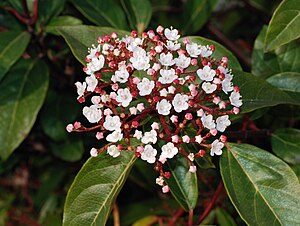Note: This is a project under development. The articles on this wiki are just being initiated and broadly incomplete. You can Help creating new pages.
Viburnum tinus - Laurustinus viburnum
Viburnum tinus is a species of flowering plant in the family Adoxaceae, native to the Mediterranean area of Europe and North Africa. Laurus signifies the leaves' similarities to bay laurel.
Contents
[hide]- 1 Uses
- 2 Parts Used
- 3 Chemical Composition
- 4 Common names
- 5 Properties
- 6 Habit
- 7 Identification
- 8 List of Ayurvedic medicine in which the herb is used
- 9 Where to get the saplings
- 10 Mode of Propagation
- 11 How to plant/cultivate
- 12 Commonly seen growing in areas
- 13 Photo Gallery
- 14 References
- 15 External Links
Uses
Nausea, Vomiting, Ulcers, Dysentery, Dysmenorrhoea, Uterine colic, Hemorrhage, Diarrhea, Sore throats
Parts Used
Chemical Composition
Methyl (2R-3-α-L-rhamnopyranosyloxy)glycerate, methyl (3R-4-α-L-rhamnopyranosyloxy-3-hydroxy)butanoate, bridelionoside B, (6S,7E,9R)-roseoside, linarionoside A, 3,7,11-trimethyl-1,6-dodecadien-3,10,11-triol, (+)-8-hydroxylinalool, β-sitosterol and daucosterol.[1]
Common names
| Language | Common name |
|---|---|
| Kannada | |
| Hindi | |
| Malayalam | |
| Tamil | |
| Telugu | |
| Marathi | NA |
| Gujarathi | NA |
| Punjabi | NA |
| Kashmiri | NA |
| Sanskrit | |
| English | Laurustinus viburnum |
Properties
Reference: Dravya - Substance, Rasa - Taste, Guna - Qualities, Veerya - Potency, Vipaka - Post-digesion effect, Karma - Pharmacological activity, Prabhava - Therepeutics.
Dravya
Rasa
Tikta (Bitter), Kashaya (Astringent)
Guna
Laghu (Light), Ruksha (Dry), Tikshna (Sharp)
Veerya
Ushna (Hot)
Vipaka
Katu (Pungent)
Karma
Kapha, Vata
Prabhava
Habit
Identification
Leaf
| Kind | Shape | Feature |
|---|---|---|
| Simple | Ovate–elliptic | Shiny dark green leaves are evergreen and similar in shape to those of bay laurel |
Flower
| Type | Size | Color and composition | Stamen | More information |
|---|---|---|---|---|
| Bisexual | 2-4cm long | Pinkish-white | 5-20 | Flowers Season is June - August |
Fruit
| Type | Size | Mass | Appearance | Seeds | More information |
|---|---|---|---|---|---|
| 7–10 mm | Laurustinus fruit by Wendy Cutler | With hooked hairs | - | {{{6}}} |
Other features
List of Ayurvedic medicine in which the herb is used
Where to get the saplings
Mode of Propagation
How to plant/cultivate
Landscape Uses:Border, Massing, Screen, Specimen. An easily grown plant, succeeding in both acid and alkaline soils but it is ill-adapted for poor soils and dry situations.[3]
Commonly seen growing in areas
Luxuriant type of macchia vegetation, Undergrowth in woods, Near the sea region.
Photo Gallery
Viburnum tinus fruits and blossoms, in Sierra Madrona
Template:VI-tinyViburnum tinus
References
External Links
- Ayurvedic Herbs known to be helpful to treat Nausea
- Ayurvedic Herbs known to be helpful to treat Vomiting
- Ayurvedic Herbs known to be helpful to treat Ulcers
- Ayurvedic Herbs known to be helpful to treat Dysentery
- Ayurvedic Herbs known to be helpful to treat Dysmenorrhoea
- Ayurvedic Herbs known to be helpful to treat Uterine colic
- Ayurvedic Herbs known to be helpful to treat Hemorrhage
- Ayurvedic Herbs known to be helpful to treat Diarrhea
- Ayurvedic Herbs known to be helpful to treat Sore throats
- Herbs with Fruits used in medicine
- Herbs with Leaves used in medicine
- Herbs with common name in English
- Habit - Shrub
- Index of Plants which can be propagated by Seeds
- Index of Plants which can be propagated by Layering
- Herbs that are commonly seen in the region of Luxuriant type of macchia vegetation
- Herbs that are commonly seen in the region of Undergrowth in woods
- Herbs that are commonly seen in the region of Near the sea region
- Herbs
- Ayurvedic herbs that don't have seed photos
- Adoxaceae








